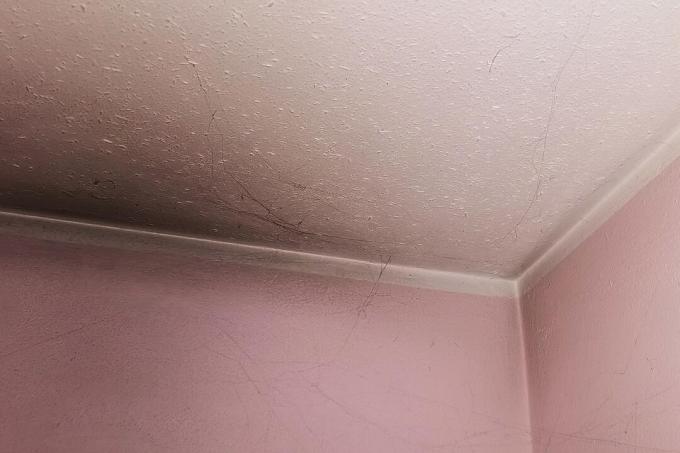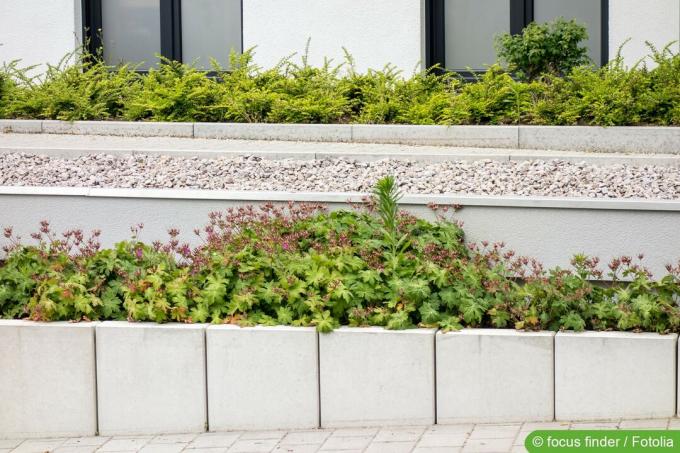

Table of contents
- problems with hitting
- Professional approach
- choice of nails
- sensible alternatives
Due to the porous properties of concrete walls, nails are only partially suitable for fastening objects in this case. Nevertheless, the attachment is successful if you follow various tips and choose the right nail.
problems with hitting
The way a nail works to fix two objects in place is simple and effective. In the case of wood, the penetrating nail compacts the surrounding material. This process provides stabilization and forces the nail into the wood. In contrast to wood, a concrete wall has completely different properties, which can lead to various difficulties. As a static and mineral structure, for example, there is no compaction when it is hammered in. Instead, the concrete wall crumbles and provides no support. If the nails are too weak, even hammering them into the wall will fail, as the nail will quickly bend due to the hardness of the material. In both scenarios, there is no stabilizing effect at all. Driven-in nails can often be removed without any problems and do not offer any support. Also problematic is the risk of cracking in a concrete wall due to splitting at the hole. In the worst case, penetrating moisture can also lead to corrosion in the wall.
Professional approach
Not only the nail itself, but also the tool has to be adapted to the intended use. Experienced do-it-yourselfers and experts therefore do not rely on a conventional hammer. A so-called compressed air nailer is used. The functional principle is similar to that of a bolt gun or a tacker. With the help of compressed air, the machines shoot nails into concrete walls. Additional accessories such as a compressed air hose and compressor are required for commissioning. However, the powerful devices have high acquisition costs, which is why the purchase is not really worthwhile for occasional or one-time use.
Danger:
The depth is difficult to regulate with said devices, which is why the tools are only suitable to a limited extent for various purposes, such as hanging pictures.
choice of nails
From wire nails to steel and brass nails to comb nails - there are a variety of nails, each serving a different task. Conventional wire nails are made of plain iron. They are suitable for the production of various wood connections or the attachment of other building materials in wood. As the name suggests, wooden nails are also not suitable for fastening in concrete walls. For brick and concrete walls, only the use of special steel nails is effective. The length should be a maximum of three centimeters to prevent the pins, which are made of hardened steel, from bending.
Tip:
Steel nails with a brass button head are often used indoors for decorative purposes. They are particularly suitable for hanging picture frames.
In addition to their exceptional robustness, special concrete nails have the property of spreading out in the nail hole and causing compaction. This ensures much-needed stability. In some cases, despite quality and hard nails, pre-drilling a small hole with a maximum width of 80 percent of the diameter of the nail is worthwhile in order to avoid bending the material impede. High-quality products are also galvanized, which allows them to be used in exterior walls. The alloy protects the nail from moisture and prevents corrosion.
sensible alternatives

Driving a nail into a concrete wall presents significant difficulties. Instead of compulsively relying on the use of a nail, it is often advisable to use a dowel. This alternative is particularly worthwhile for those who have a hammer drill that is strong enough for the concrete wall in question. These devices are also quite expensive to buy, which is why the purchase for occasional use is only worthwhile to a limited extent.
Tip:
However, both a compressed air nailer and an impact drill can be borrowed from the local hardware store or specialist shop for a small fee.
If you want to do without nails, dowels and screws, you can access various new-fangled devices. A picture can also be attached to a concrete wall in other ways. Adhesive strips or adhesive strips from well-known manufacturers offer an excellent hold on stable concrete walls. The adhesive solutions offer a strong hold even on paint or wallpaper and can usually be removed without leaving any residue.
 Home editorial office
Home editorial office
Learn more about wall / wall

Fogging: what to do against black dust on walls?
Fogging is still a foreign concept to many, although black dust on walls, ceilings and carpets has been a widespread problem since the 1990s. We give all the important information about the tiresome topic from the emergence to the fight.

Have L-bricks placed: overview of prices / costs
Making slope fortifications or edging from L-stones is one of the more challenging real estate projects. While you can certainly build smaller fortifications yourself, large amounts of earth should be supported by specialist companies. We explain what to look out for and what costs to expect.

Interior plaster: how much plaster do you need per square meter?
If interior plaster is to be applied, one question above all arises: how much plaster do you need per square meter? Because too much material causes unnecessary costs. Too little plaster is annoying because it takes time and money to buy again.

Brick Wall: Remove plaster from bricks
Removing plaster from a brick wall takes effort and careful handling. Bricks are delicate and crack/break easily. Here sensitivity and the right instructions are required, which experts have created for hobby craftsmen and those who want to become one.

Drain house & masonry | Cost & Duration
Anyone who needs to have their house and masonry drained has a choice of different methods. We offer here how the costs can be, how long it can take and other important facts.

Calculate dew point on the wall | 5 information on dew point calculation
The dew point is an important tool, especially when insulating buildings. It indicates where the temperature is so low that water vapor condenses as moisture. For help with calculating how this value is determined, see the guide.



